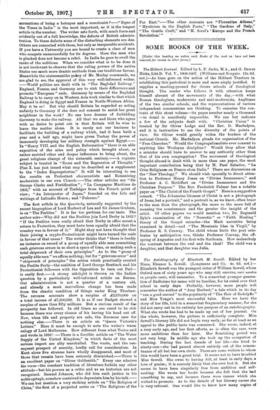SOME BOOKS OF THE WEEK.
[Under this heading we notice such Books of the week as hare not bun reserved for review in other forms.1
The Hibbert Journal. Edited by L. P. Jacks, M.A., and G. Dawes Hicks, Litt.D. Vol. V., 1906-1907. (Williams and Norgate. 12s. 6d. net.)—As time goes on the action of the Hibbert Trustees in establishing this periodical is more and more ainply justified. It supplies a meeting-ground for divers schools of theological thought. The reader who follows it with attention keeps himself abreast of the movements of the day,—with what Roman theologians, modernists and anti-modernists, Anglicans of the two similar schools, and the representatives of various independent communions are thinking. To examine the con- tents of this stout volume—its pages number nearly a thousand —in detail is manifestly impossible. We can but indicate a few of the subjects dealt with. "Christian Union" is treated by Sir Oliver Lodge and the Rev. D. Macfadyen, and it is instructive to see the diversity of the points of view. Sir Oliver would greatly widen the borders of the national Church. Mr. Macfadyen pleads for organisation of the "Free Churches." Would the Congregationalists ever consent to anything like Wesleyan discipline ? Would they allow that a minister should have to answer to any authority other than that of his own congregation? The movement of theological thought abroad is dealt with in more than one paper, the most important contribution being that by M. Paul Sabatier, " La Crise Religiense en France et en Italie." There are discussions on the " New Theology." We should wish specially to direct atten- tion to Professor Henry Jones on "Divine Immanence," and Professor A. C. McGiffert on "Divine Immanence and the Christian Purpose." The Rev. Frederick Palmer has a notable paper on " The Christ of the Fourth Gospel." Here is a suggestive remark. "The Johannine likeness of Christ is not a photograph of Jesus, but a portrait," and a portrait is, as we know, often truer to the man than the photograph, the more so the more full of meaning the countenance and the greater the insight of the artist. Of other papers we would mention two, Dr. Reginald Ryle's examination of the " Neurotics " or "Faith Healing" theory of the Gospel miracles—the Mark narrative being examined in detail—and " The Messianic Idea iu Virgil," by Professor R. S. Conway. The child whose birth the poet cele- brates by anticipation was, thinks Professor Conway, the off- spring of Augustus and his first wife Scribonia. How melancholy the contrast between the real and the ideal! The child was a daughter, and that daughter was Julia.










































 Previous page
Previous page